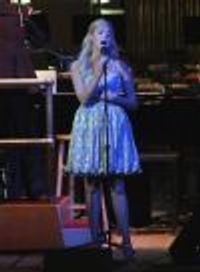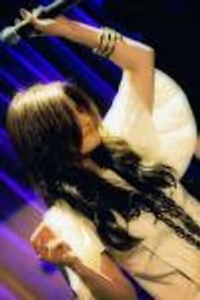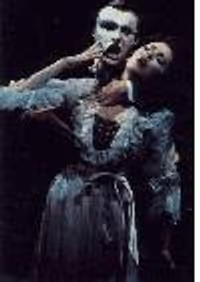Can a man singer be a belter?
#25re: Can a man singer be a belter?
Posted: 5/4/05 at 8:20am
trpguyy, you are absolutley right.
Head voice and falsetto are not the same thing. Every voice has a belt register, a head voice, and a falsetto, it's just that for many men, the vocal chords are too thick to produce a belt, and with women, the opposite with falsetto.
A man's opera voice is a head voice.
A man can belt too, and anyone can belt any note in their range when done properly (don't ask me, don't know how, but i've been to three seminars and seen three different people (one man, two women) do it. Good examples of male belting are Joel Grey in Cabaret and Jerry Orbach.
#26re: Can a man singer be a belter?
Posted: 5/4/05 at 8:31amMen can most certainly belt. I'm famous in my school for my belting.
#27re: Can a man singer be a belter?
Posted: 5/4/05 at 8:31amWhen I sing in my chest voice - I always think of it as belting, if it's a big, showy number with long, sustained notes. But when I'm singing in my head voice, there's no belting involved.
#28re: Can a man singer be a belter?
Posted: 5/4/05 at 12:08pmActually, head voice and falsetto are synonyms. You can ask any voice teacher and they'll tell you the same. There is, however, a placement in your voice that you can blend the falsetto with your chest voice so that your falsetto notes can sound MORE like your chest. (louder) But there are not 2 different places in a male's voice where it switches. It's just a matter of how much you use your diaphragm to get those falsettos to ring louder and stronger.
#29re: Can a man singer be a belter?
Posted: 5/4/05 at 12:28pmmen can most definitely belt. some can belt higher than some women.
#30re: Can a man singer be a belter?
Posted: 5/4/05 at 12:41pm
I gotta disagree with the term belting only applying to women (or being a female-centric ability) as well as the idea that people only have one break (or at least, women only).
Most people have more than one break and it can often extend over a range of notes.
I have a VERY high-set voice for a man (I am a high tenor/countertenor) but I have a weird low break out of my chest into a mix sound (it's around F at the top of the staff). It's only in one or two notes, generally F/F#/G. Then I have a second, more minor break where my mix sound becomes less chest-oriented and more head-oriented around C/C#/D above the staff. From there, I get a head-only or falsetto sound that leads into my countertenor range a few notes later, around E/F above the staff.
So, I have three breaks. The trick is developing your technique around these breaks so that the sound is seamless and the switch isn't noticeable.
One of the GREATEST musical theatre singers at hiding her break is the fabulous Marin Mazzie. If you listen to here voice from its lowest to its highest, there is no break in the quality of the voice.
Other women, like Sara Ramirez (whose voice I love), have HUGE and noticeable breaks. Even Kristin Chenoweth has a very noticeable break going from her belty chest sound into a purely legit head-only sound. You can often note the location of a break by the fact that the quality of their voice changes completely. This is certainly true of the musical theatre women these days who belt the crap out of things and then get this really shaky, bizarre head sound (like Eden Espinosa, when she tries to sing soprano).
So, this had little to do with the original question, but yeah, anyone can belt, no matter their range. It's a quality of sound, not a range of notes you can hit.
Gothampc
Broadway Legend Joined: 5/20/03
#31re: Can a man singer be a belter?
Posted: 5/4/05 at 12:53pmI think what made Merman so special was that she was belting while others were not. Merman had the unique quality that she didn't have a break in her voice, or if she did, it was very well hidden.
#32re: Can a man singer be a belter?
Posted: 5/4/05 at 1:09pm
Merman probably never showed her break because she had what is often referred to as a "Trick voice." THat is, her belt range was so unbelievably large that people could write songs with ranges in which she could belt from the bottom note to the top. So you never really heard her break.
iluvtheatertrash
Broadway Legend Joined: 11/9/04
#33re: Can a man singer be a belter?
Posted: 5/4/05 at 1:27pmDefinately. A lot of male performers have powerful chest voices and insist on getting the higher notes out on them and not relying on a falsetto/head voice/etcetera.
B.B. Wolf
Broadway Legend Joined: 7/26/04
#34re: Can a man singer be a belter?
Posted: 5/4/05 at 1:31pm
Dang it. This is what I get for going to bed early last night. I love these topics. ![]()
The thread title is actually a bit of a trick question. Vocal pedagogists have been trying to agree on a definition for "belting" for DECADES and still do not have a completely delineated description. ie - lots of people do it differently and achieve the sounds normally called "belting" in different ways. However, what they can agree on is that it is produced through a constriction (slight in some, pervasive in others) of the vocal cords and is ultimately destructive for the voice. The term "healthy belt" is an oxymoron. There are teachers who can teach minimal strain while belting to achieve the current "pop-broadway" sound (Liz Caplan). But, no one can teach unstrained belting because it does not exist. (This is why it is ultimately a BAD road for the Broadway musical to take!! Okay, that's for a different thread...)
That being said ![]() men can most DEFINITELY make the sound most people call belting. In pop and rock, mix voice is anathema. Both women and men in those genres are belting. Do you think when Adam Pascal cranks out a high note and his veins come a-bulging out of his neck that he's singing in a relaxed mix voice?!? Or that a director would actually want their tenor to sing "Pity the Child" in a relaxed covered mix voice when he rips out the high C's?
men can most DEFINITELY make the sound most people call belting. In pop and rock, mix voice is anathema. Both women and men in those genres are belting. Do you think when Adam Pascal cranks out a high note and his veins come a-bulging out of his neck that he's singing in a relaxed mix voice?!? Or that a director would actually want their tenor to sing "Pity the Child" in a relaxed covered mix voice when he rips out the high C's? ![]()
#35re: Can a man singer be a belter?
Posted: 5/4/05 at 1:43pm
Oh, bitches...
I belt!
For other male belters, see Nick Cearley.
#36re: Can a man singer be a belter?
Posted: 5/4/05 at 1:45pmHehe, BCuttrell does indeed belt. So do lots of men.
Tirso de Molina
Featured Actor Joined: 1/1/05
#37re: Can a man singer be a belter?
Posted: 5/4/05 at 2:44pmAs a side note, some voice teachers do argue that women have a falsetto voice -- but it's rarely used and, just like a male countertenor voice, needs to be developed. The best example usually cited of a woman's falsetto is Berry Boop's voice in cartoons. I wonder if Ellen Greene might not be an an example of a female singer who at least CAN employ some falsetto?
Mr. TN
Stand-by Joined: 12/2/03
#38re: Can a man singer be a belter?
Posted: 5/4/05 at 3:07pmOperetic tenors use a technique called covering to place the sound higher in the mask of the face. This technique releases the tension in the throat and does not require nearly the amount of pressure that Broadway belters do. This is why they can sustain high B's and C's in full voice (which is without using falsetto). Men have three colors of voice. Chest, head, and falsetto. And NO head and falsetto are not the same. Head voice is defined as placement of the sound high in the mask as opposed from the diaphragm. Basses and baritones tend to use the deep resonnance of the chest to round out lower notes. Tenors need to be able to place the sound in their head or higher notes sound weak and unrefined. Falsetto is when sound is completely placed in the sinus cavity. The quality of falsetto and head voice are different. Falsetto is weaker than head voice and cannot take the pressure of full force singing. Cover on the head voice is what allows Operetic tenors to sound like they are singing instead of screaming. RENT and other pop shows use the "screaming" technique instead of cover to rid themselves of the operetic sound. That is why many pop singers have vocal problems. The natural cover voice helps keep the vocal apparatus healthy by releaving the pressure in the larynx. Belting as it applies to both men and women is much more risky as improper tension can cause the vocal folds to inflame and rupture. Vocal polyps form in this manner. Again, each sound has its place in music.
Jwaa
Broadway Star Joined: 11/28/04
#39re: Can a man singer be a belter?
Posted: 5/4/05 at 3:50pm
umm so confused with all the technical details...but for example
in the BARE recording...in Role Of A Lifetime....is michael arden belting on the word STAY in the line:
'what happens when the music stops...in the silence will he STAY!'
?????
if so...woo hoo i can belt lol.
X
#40re: Can a man singer be a belter?
Posted: 5/4/05 at 3:54pmTechniclly I dont think a guy can but it is very possible. I myself tend to belt alot of my notes but it isnt forced its sorta natrual. I think that if you try to make yourself belt it will be difficult but very possible.
"I am sorry but it is an unjust world and virtue is only triumphant in theatricle performances" The Mikado
#41re: Can a man singer be a belter?
Posted: 5/4/05 at 4:07pm
"Other women, like Sara Ramirez (whose voice I love), have HUGE and noticeable breaks. Even Kristin Chenoweth has a very noticeable break going from her belty chest sound into a purely legit head-only sound"
That is more an effect of change in placement or style. Those who sing with no breaks in their voice usually are singing in a mix throughout their entire range. Those who have a break may either be going from full chest to head or mix, or from mix to head voice.
sassypanz
Broadway Star Joined: 1/20/05
#42re: Can a man singer be a belter?
Posted: 5/4/05 at 4:18pm"Belt" is a term used for girls when they sing in a strong chest voice and projecting. Belt isnt a right term for men singing.
#43re: Can a man singer be a belter?
Posted: 5/4/05 at 10:30pmok im a mixer and it sounds like im belting but im not and i can go high than most guys can go,i have a chest voice also which i can belt from. but with my technique u cant tell whether im in chest voice or head voice lol im all mix baby and thats how it goes.I can belt if i want to , im a baritone,tenor,countertenor and then i have my mix so yeah i have a wide ranged of vocal things that i can do i have a crazy range and a range of **** that mnost men cant do but mix is so much healthier than chest belting.Shoshana bean is mix (or chest mix) but my mix isint chest mix(well i have that also and i can do it) my mix is head voice and chest voice combined and it sounds great(listen to marty thomas thats my technique)but all that opera and cvhest miz and baritone stuff i can do.I mtrained in a lot
#45re: Can a man singer be a yeller?
Posted: 5/4/05 at 10:50pm
Can a man singer be a yeller?
We all know women can.
Beergoggles
Broadway Legend Joined: 4/30/05
#46re: Can a man singer be a yeller?
Posted: 5/5/05 at 7:05amMen can belt! I was taught at drama school how to belt safely.... to be quite frank i think it's easier for a man to belt than a woman. The whole thing about belting is controlling the tilt and larynx movements if i remember correctly.
#47re: Can a man singer be a yeller?
Posted: 5/5/05 at 8:08am
to my knowledge, the actual definition of belting is forcing the sound through the throat, which is not safe at all, and can be extremely dangerous if done too much.
What people learn as "safe belting" sounds almost the same, but really isn't belting at all. Belting refers to a particular way of exploiting the vocal apparatus rather than the sound that is produced.
And to answer the question, a man can certainly acheive a belt sound, even classical singers. Listen to Franco Corelli. He most certainly got a belt sound, even if it was operatic, on his high notes.
#48re: Can a man singer be a yeller?
Posted: 5/5/05 at 9:49am
"That is more an effect of change in placement or style. Those who sing with no breaks in their voice usually are singing in a mix throughout their entire range. Those who have a break may either be going from full chest to head or mix, or from mix to head voice. "
An effect of change in placement or style is a way to describe a break. It's a point when you can no longer continue singing with the same placement and there's a shifting. Listen to Marin Mazzie sing. She does indeed mostly use a mix but there's a definite range (it's rather low, granted) where it's chest only, but the transition into a chest/head mix is extremely fluid and her transition into full head is also fluid. The result is a sound that is uniform throughout her entire range.
Chenoweth cannot transition from her poppy "Broadway" sound into her full head without a noticeable shift in sound and style. That right there is a break.
nancipants
Swing Joined: 3/16/04
#49re: Can a man singer be a yeller?
Posted: 5/5/05 at 10:12am
"I just asked Michael Ball...and yes, men can belt."
Um Princeton - there is a problem here. I know Michael Ball and Michael Ball is not really a man.
Videos











